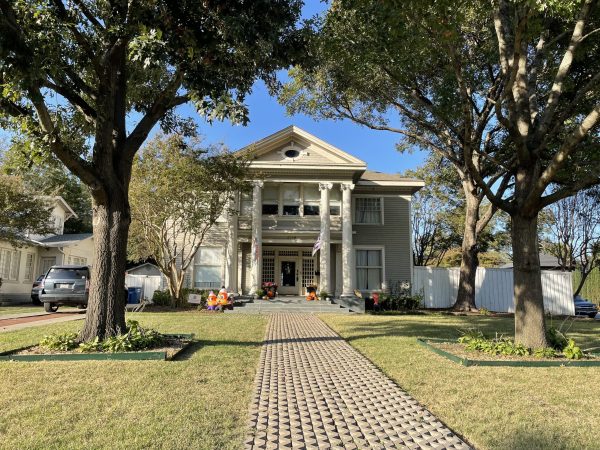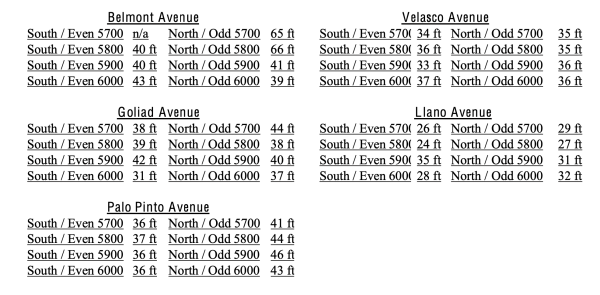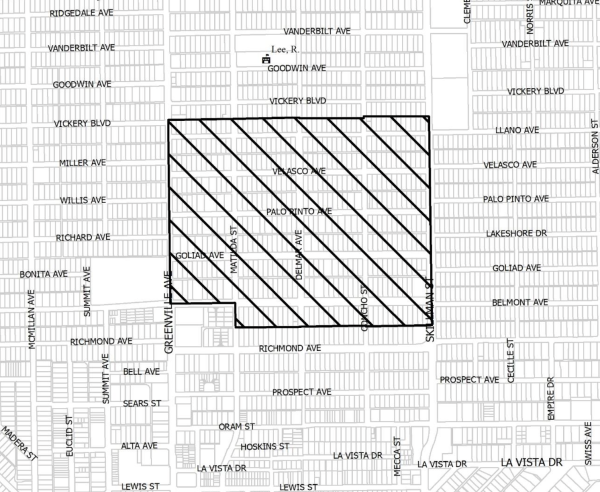
A house on Belmont Avenue. Photo by Renee Umsted.
Update (11/19): The story has been updated with new language regarding requirements for a work review.
Belmont Addition Conservation District neighbors are celebrating today.
Years after the process to change the district’s ordinance began, the Dallas City Council unanimously approved several revisions neighbors have been wanting for years.
“This is clearly a case of neighborhood self-determination,” Geyden Sage, the chair of the neighborhood committee who led the amendment process, told the Council. “I know that you all support that, so I’m asking today that you just vote ‘yes’ and help us amend our ordinance so that it better reflects the spirit and the intent of the conservation district.”
All of the neighbors who spoke at the meeting expressed support for the amendments.
“This was a complex effort, as we’ve heard from several of the speakers, with a lot of different points of view, but I’m very pleased to see that they all came to a consensus in the end,” District 14 City Council member Paul Ridley said at the meeting.
Melissa Kingston is a Belmont Addition neighbor who was a leader in the effort to create the conservation district. Earlier this year, she said she didn’t support a few of the changes to the ordinance, such as the ones relating to Craftsman stye architecture. But she changed her mind.
“I feel like these changes adequately represent the consensus at the community meetings, and I fully support the passage of this amendment,” Kingston said at the meeting.
Sage says she thinks most of the changes are “minimal but are important.”
The revised ordinance can be found here, and here’s the previous ordinance, last updated in 2019. Changes to the ordinance include:
- Modifying the requirements for fence height and location
- The maximum fence height was raised to nine feet from six feet for fences in rear and side yards.
- Fences in the side yard must be set back at least five feet behind the main plane of the front facade.
- Modifying the requirements for front yard setbacks
- The following image shows the minimum front yard setbacks for new construction. All original or contributing (Colonial Revival, Craftsman, Prairie or Tudor) homes are conforming in terms of front yard setbacks. If one of these structures is torn down, the new construction must meet the regulations.

Front yard setbacks for Belmont Addition CD.
- The following image shows the minimum front yard setbacks for new construction. All original or contributing (Colonial Revival, Craftsman, Prairie or Tudor) homes are conforming in terms of front yard setbacks. If one of these structures is torn down, the new construction must meet the regulations.
- Clarifying language to ensure nonconforming structures can be repaired, remodeled and replaced
- Documented assurance has been added as a term. It refers to an architectural drawing, survey or photograph showing the original or existing appearance, height or footprint of a structure. Documented assurance should be used to repair, remodel and replace nonconforming features.
- For a structure that is nonconforming, neighbors can present documented assurance and make repairs or remodel, continuing as a nonconforming structure. But structures can’t become more nonconforming.
- Clarifying language to detail the requirements for a work review
- Work review applications must be submitted to the director of the department of development services for any work regulated by the standards included in the ordinance. This is less strict than the previous rule, which required a review form application for any exterior alteration of a front facade or wrap-around and for new construction.
- Modifying the second story restriction on Craftsman style structures
- The second story must be set back a minimum of five feet from the main plane of the front facade. The restriction that the second story may not be more than 70% of the floor area of the first story was removed.
- Modifying architectural standards for new construction and remodeling to promote the conservation of Craftsman style structures
- If an original or contributing Craftsman house is torn down, the front facade and wrap-around of new construction on the same lot has to be built in the Craftsman style.
- New construction structures built in the Craftsman style must now have at least seven (not six) features included in the ordinance. A clipped gable (jerkinhead) roof, dentil molding, lap siding with a reveal of not less than 2.5 inches and not greater than 5 inches, and nested gables were added to the list of Craftsman features.
- Front porches are now required for Craftsman style structures.
- Modifying the development standards for driveway access
- The stipulation that an interior lot may have driveway access from either the front street of the alley but not both was eliminated. Corner lots can now have driveway access from an alley in addition to either the front street or a side street.
- If a lot has driveway access from the street and alley, vehicular through-access is not allowed.
Back story

The Belmont Addition Conservation District.
Neighbors in the conservation district, originally created in 2004, were growing frustrated. The ordinance regulations meant to conserve the historic structures that define the area seemed to be doing more harm than good.
Many structures, particularly Craftsman homes in disrepair, were being destroyed and replaced with large homes that took up the whole lot space and didn’t match the surrounding homes.
Neighbors involved in the earliest efforts to create a conservation district were hoping to regulate builders. But the ordinance ended up causing problems for themselves.
“We can’t renovate our home or maximize our space,” Geyden Sage told The Advocate in 2019. “We’re trying to remove that language altogether so people can renovate instead of tearing them down.”
Initial meetings were held for neighbors and City staff members in 2019 to discuss potential changes to the ordinance and the amendment process. Later, Geyden and Barry Sage, who have lived in their Belmont Avenue home since 1997, began collecting signatures to keep the process moving forward.
The City of Dallas requires signed petitions signaling approval of the amendment process to comprise 58% of the land or 58% of the lots in the conservation district.
Neighbors were given 15 months to reach that threshold. By the time COVID-19 caused lockdowns, the Sages had already gotten enough petitions signed. But they wanted to reach out to more neighbors. Sustainable Development and Construction staff told them they could have an extension, so they missed the Nov. 6, 2020, deadline and turned in the petitions Dec. 10. At that point, 77% of the area’s neighbors supported the amendments.
Earlier this year, after a question was raised about the SDC’s decision on the deadline extension, neighbors were told they shouldn’t have received an extension, and the process came to a halt.
But neighbors didn’t give up. Years ago, a hearing was authorized to amend the conservation district to allow for additional dwelling units. At that meeting, neighbors talked about their concerns with driveway access and parking. Ridley, who was on the CPC at the time, authorized a hearing at a later date to address those concerns. Neighbors were allowed to amend the authorized hearing to include all of the language included in the petition, which allowed the ordinance-amendment process to continue.
“I’m thankful that the neighborhood worked together, came together at the end,” Geyden says.
What’s next
Earlier this year, Geyden said she and her husband wanted to expand the second level of their home. They were prevented from doing that because of the conservation district ordinance. But not anymore. The Sages are now planning to make the changes they wanted.
“People looked so light and happy, and I can’t wait to see my neighbors build their driveway, build their garage and access it from the back,” Geyden says. “People are so ecstatic and happy that they can now make the desired improvements and access to their homes.”
At the meeting, City Council members heralded Belmont as an example for other neighborhoods throughout Dallas working through similar processes.
“To other neighborhoods in the City of Dallas who think that the problem is with the City, who think that they can’t do anything about their limitations or ordinance that is encumbering their neighborhood or their well-being, I’d like to send the message that it is hard. It is difficult, but it can be done,” Geyden says. “And if you just take the things that people tell you at face value, you’re never going to drive change.”





